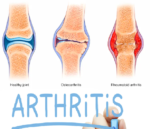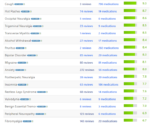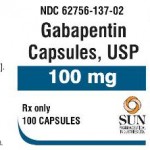Epilepsy causes your brain to send abnormal signals. This activity can lead to seizures. Seizures can occur for a number of reasons, such as injury or sickness. Epilepsy is a condition that causes recurrent seizures. There are several types of epileptic seizures. Many of them can be treated with antiseizure medications.
Drugs used to treat seizures are called antiepileptic drugs (AEDs). According to the National Institute of Neurological Disorders and Stroke, there are more than 20 prescription AEDs available. Your options depend on your age, your lifestyle, the type of seizures you have, and how often you have seizures. If you’re a woman, they also depend on your chance of pregnancy.

What are Anticonvulsants?
the List of Anticonvulsants
Below is a list of some of the most common brand-name drugs currently used to treat epilepsy. Your doctor may prefer that you take the brand name of anticonvulsant and not the generic substitution. Talk with your doctor about this important issue.
Brivaracetam (Briviact)
- Approved for use as an add-on treatment to other medications in treating partial onset seizures in patients age 16 years and older.
- Possible side effects include drowsiness, dizziness, fatigue, nausea and vomiting.
Cannabidiol (Epidiolex)
- Approved in 2018 for treatment of severe or hard-to-treat seizures including those in patients with Lennox-Gastaut syndrome and Dravet syndrome.
- Common side effects include lethargy, sleepiness, fatigue, increased appetite, diarrhea and sleep disorders.
Carbamazepine (Carbatrol or Tegretol)
- For partial, generalized tonic-clonic and mixed seizures
- Common adverse effects include fatigue, vision changes, nausea, dizziness, rash.
Cenobamate (Xcopri)
- For use in adults with partial onset seizures
- Common side effects include insomnia, dizziness, fatigue, diplopia, and headache were most common in trials
Diazepam ( Valium) , lorazepam (Ativan) and similar Benzodiazepine tranquilizers such as clonazepam (Klonopin)
- Effective in short-term treatment of all seizures; used often in the emergency room to stop a seizure, particularly status epilepticus
- Tolerance develops in most within a few weeks, so the same dose has less effect over time.
- Valium can be given orallly, as an injection, in an IV or as rectal suppository.
- Side effects include tiredness, unsteady walking, nausea, depression, and loss of appetite. In children, they can cause drooling and hyperactivity.
Eslicarbazepine (Aptiom)
- This drug is a once-a-day medication used alone or in combination with other anti-seizure drugs to treat partial-onset seizures.
- The most common side effects include dizziness, nausea, headache, vomiting, fatigue, vertigo, ataxia, blurred vision, and tremor.
Ethosuximide (Zarontin)
- Used to treat absence seizures
- Adverse effects include nausea, vomiting, decreased appetite, and weight loss.
Felbamate (Felbatol)
- Treats partial seizures alone and some partial and generalized seizures in Lennox-Gastaut Syndrome; is used rarely and only when no other medications have been effective.
- Side effects include decreased appetite, weight loss, inability to sleep, headache, and depression. Although rare, the drug may cause bone marrow or liver failure. Therefore, the use of the drug is limited and patients taking it must have blood cell counts and liver tests regularly during therapy.
Fenfluramine (Fintepla)
- Schedule IV drug approved for treatment seizures in patients 2 and older who have Dravet syndrome.
- Common side effects include lose of appetite, vomiting, lethargy, problems with coordination including standing or walking, increased blood pressure, drooling, diarrhea, constipatipation.
Lacosamide (VIMPAT)
- This drug is approved to treat partial-onset seizures in adults with epilepsy.
- VIMPAT can be used alone or with other drugs.
- The drug comes as tablets, an oral solution, or injection.
- Side effects include dizziness, headache, and nausea.
Lamotrigine (Lamictal)
- Treats partial, some generalized seizures and mixed seizures.
- Has few side effects, but rarely people report dizziness, insomnia, or the potentially deadly Stevens Johnson rash.
Levetiracetam (Keppra)
- It is combined with other epilepsy drugs to treat partial seizures, primary generalized seizures and myoclonic (shock-like jerks of muscle) seizures.
- Side effects include tiredness, weakness, and behavioral changes.
Oxcarbazepine (Oxtellar XR, Trileptal )
- Used to treat partial seizures, it is a once-daily medicine used alone or with other medications to control seizures.
- Common side effects include dizziness, sleepiness, headache, vomiting, double vision , and balance problems.
Perampanel (Fycompa)
- The drug is approved to treat partial onset seizures and primary generalized tonic-clonic seizures in those age 12 and older.
- The label carries a warning of potential serious events including irritability, aggression, anger, anxiety, paranoia, euphoric mood, agitation, and changes in mental status.
Phenobarbitol
- Oldest epilepsy medicine still in use. It is used to treat most forms of seizures and is known for its effectiveness and low cost.
- Side effects can be sleepiness or changes in behavior.
- Controls partial seizures and generalized tonic-clonic seizures; also can be given by vein (intravenously) in the hospital to rapidly control active seizures, although if the drug is being delivered by IV, fosphenytoin (Cerebyx) is usually used.
- Side effects include dizziness, fatigue, slurred speech, acne, rash, gum thickening, and increased hair (hirsutism). Over the long term, the drug can cause bone thinning.
Pregabalin (Lyrica)
- Used with other epilepsy drugs to treat partial seizures, but is used more often to treat neuropathic pain.
- Side effects include dizziness, sleepiness (somnolence), dry mouth, peripheral edema, blurred vision, weight gain, and difficulty with concentration/attention.
Tiagabine (Gabitril)
- Used with other epilepsy drugs to treat partial seizures with or without generalized seizures
- Common side effects include dizziness, fatigue, weakness, irritability, anxiety, and confusion.
Topiramate (Topamax)
- Used with other drugs to treat partial or generalized tonic-clonic seizures. It is also used with absence seizures.
- Side effects include sleepiness, dizziness, speech problems, nervousness, memory problems, visions problems, weight loss.
Valproate, valproic acid (Depakene, Depakote)
- Used to treat partial, absence, and generalized tonic-clonic seizures
- Common side effects include dizziness, nausea, vomiting, tremor, hair loss, weight gain, depression in adults, irritability in children, reduced attention, a decrease in thinking speed. Over the long term, the drug can cause bone thinning, swelling of the ankles, irregular menstrual periods. More rare and dangerous effects include hearing loss, liver damage, decreased platelets (clotting cells), and pancreas problems.
- Should not be taken if pregnant.
Zonisamide (Zonegran )
- Used with other drugs to treat partial, generalized and myoclonic seizures
- Adverse effects include drowsiness, dizziness, unsteady gait, kidney stones, abdominal discomfort, headache, and rash.
What is the evidence for adjunctive anticonvulsants?
Moderate to low quality evidence suggests a medium-sized effect of improved mental health with adjunctive lamotrigine as measured on some but not all assessment scales, and with adjunctive valproate, particularly in the short-term (< 4 weeks). Lamotrigine is associated with an increased risk of any adverse effect compared to placebo.
There may be some benefit of adjunctive valproate for reducing aggressive behaviour in the short term (1 week), but not in the longer term (4 weeks). There is a lower risk of constipation and tardive dyskinesia with valproate, but an increased risk of sedation compared to placebo.
Moderate to low quality evidence suggests no improvements in symptoms after augmenting clozapine with lamotrigine or topiramate in treatment-resistant patients.
Pain Medications, Pain Relief, and Pain Management







